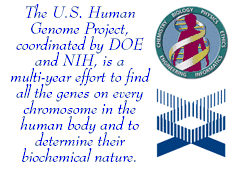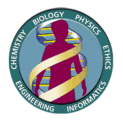 |
|
 |
|
Basic
Information
 FAQs FAQs
 Glossary Glossary
 Acronyms Acronyms
 Links Links
 Genetics 101 Genetics 101
 Publications Publications
 Meetings Calendar Meetings Calendar
 Media Guide Media Guide
About
the Project
 What is it? What is it?
 Goals Goals
 Landmark Papers Landmark Papers
 Sequence Databases Sequence Databases
 Timeline Timeline
 History History
 Ethical Issues Ethical Issues
 Benefits Benefits
 Genetics 101 Genetics 101
 FAQs FAQs
Medicine
&
the New Genetics
 Home Home
 Gene
Testing Gene
Testing
 Gene
Therapy Gene
Therapy
 Pharmacogenomics Pharmacogenomics
 Disease Information Disease Information
 Genetic Counseling Genetic Counseling
Ethical,
Legal,
Social Issues
 Home Home
 Privacy
Legislation Privacy
Legislation
 Gene
Testing Gene
Testing
 Gene
Therapy Gene
Therapy
 Patenting Patenting
 Forensics Forensics
 Genetically
Modified Food Genetically
Modified Food
 Behavioral
Genetics Behavioral
Genetics
 Minorities,
Race, Genetics Minorities,
Race, Genetics
 Human Migration Human Migration
Education
 Teachers Teachers
 Students Students
 Careers Careers
 Webcasts Webcasts
 Images Images
 Videos Videos
 Chromosome
Poster Chromosome
Poster
 Presentations Presentations
 Genetics 101 Genetics 101
 Genética
Websites en Español Genética
Websites en Español
Research
 Home Home
 Sequence Databases Sequence Databases
 Landmark Papers Landmark Papers
 Insights Insights
Publications
 Chromosome Poster Chromosome Poster
 Primer Molecular Genetics Primer Molecular Genetics
 List of All Publications List of All Publications
 Search This Site Search This Site
 Contact Us Contact Us
 Privacy Statement Privacy Statement
 Site Stats and Credits Site Stats and Credits
 Site Map Site Map
|

Major Events in the
U.S. Human Genome Project
and Related Projects
Acronyms listed below
See also Post-HGP Milestones & Progress
2008
2006
2005
2004
- Human
Chromosome 16 Completed, December 2004.
- Landmark Paper: Finishing
the euchromatic sequence of the human genome, Nature,
Oct. 21, 2004
- Human Gene Count Estimates Changed to
20,000 to 25,000, October 2004.
- Human
Chromosome 5 Completed, September 2004.
- Landmark Paper: Human
genome: Quality assessment of the human genome sequence. Nature
429, 365-368 (27 May 2004)
- Human
Chromosome 9 Completed, May 2004.
- Human
Chromosome 10 Completed, May 2004.
- Human
Chromosome 18 Completed, March 2004.
- Human Chromosome 19 Completed,
March 2004.
- Human
Chromosome 13 Completed, March 2004.
2003
2002
2001
- Human
Chromosome 20 Finished - Chromosome 20 is the third chromosome completely
sequenced to the high quality specified by the Human Genome Project.
- Publication of Initial Working Draft Sequence February
12, 2001
Special issues of Science (Feb. 16, 2001) and Nature (Feb.
15, 2001) contain the working draft of the human genome sequence. Nature
papers include initial analysis of the descriptions of the sequence
generated by the publicly sponsored Human Genome Project, while Science
publications focus on the draft sequence reported by the private company,
Celera Genomics. A press conference was held at 10 a.m., Monday, February
12, 2001, to discuss the landmark publications. Links for more information
are:
Science
Nature
Human
Genome Project and the Private Sector: A Working Partnership
Webcast of HGP Press Conference
(Mon. Feb. 12, 2001)
Press
releases on First Analysis of Genome Sequence
 Pieter
de Jong's team (now at the Oakland Children's Hospital, Oakland, CA)
was a major provider of the BAC
libraries used in the sequencing of the human and several other
genomes. Pieter
de Jong's team (now at the Oakland Children's Hospital, Oakland, CA)
was a major provider of the BAC
libraries used in the sequencing of the human and several other
genomes.
2000
- HGP leaders and President Clinton announce
the completion of a "working draft" DNA sequence of the human genome.
- Press briefing and remarks
 An
Interview with Ari Patrinos, Director U.S. DOE Human Genome Program An
Interview with Ari Patrinos, Director U.S. DOE Human Genome Program
 Craig
Venter (head of Celera Genomics), Ari Patrinos (director of DOE
Human Craig
Venter (head of Celera Genomics), Ari Patrinos (director of DOE
Human
Genome Program and Biological and Environmental Research Program),
and Francis Collins (director, NIH National Human Genome Research
Institute).
- International research consortium publishes chromosome
21 genome, the smallest human chromosome and the second to be completely
sequenced.
- DOE researchers announce completion of chromosomes
5, 16, and 19 draft sequence.
- International collaborators publish genome of fruit fly Drosophila
melanogaster.
- President Clinton signs executive order prohibiting federal departments
and agencies from using genetic information in hiring or promoting workers.
More.
1999
1998
Acronyms
1997
Acronyms
1996
Acronyms
1995
Acronyms
1994
Acronyms
1993
- International IMAGE
Consortium established to coordinate efficient mapping and sequencing
of gene-representing cDNAs.
- The Scientist 13[4]:17, Feb. 15, 1999 Hot
Papers In Genomics:
G. Lennon, C. Auffray, M. Polymeropoulos, M.B. Soares, "The I.M.A.G.E.
Consortium: An Integrated Molecular Analysis of Genomes and Their
Expression," Genomics, 33:1512, 1996. (Cited in more than 290 papers
since publication)
- DOE-NIH ELSI Working Group's Task Force on Genetic and Insurance Information
releases recommendations.
- DOE
and NIH revise 5-year goals [Science 262, 43-46 (Oct.
1, 1993)].
- French Généthon provides mega-YACs to the genome community.
- IOM
releases U.S. HGP-funded report, "Assessing Genetic Risks."
- LBNL implements novel transposon-mediated chromosome-sequencing system.
- GRAIL sequence-interpretation
service provides Internet access at ORNL.
 Acronyms Acronyms
1992
- Low-resolution genetic linkage map of entire human genome published.
- Guidelines
for data release and resource sharing announced by DOE and NIH.
Acronyms
1991
- Human chromosome mapping data repository, GDB,
established.
Acronyms
1990
Acronyms
1989
Acronyms
1988
- Reports by congressional OTA and NAS NRC committees recommend concerted
genome research program.
- HUGO founded by scientists
to coordinate efforts internationally.
- First annual Cold Spring Harbor Laboratory meeting on human genome
mapping and sequencing.
- DOE
and NIH sign MOU outlining plans for cooperation on genome research.
- Telomere (chromosome end) sequence having implications for aging and
cancer research is identified at LANL.
Acronyms
1987
- Congressionally chartered DOE advisory committee, HERAC,
recommends a 15-year, multidisciplinary, scientific, and technological
undertaking to map and sequence the human genome. DOE designates multidisciplinary
human genome centers.
- NIH NIGMS begins funding of genome projects.
Acronyms
1986
- Following the Santa Fe conference, DOE OHER announces Human Genome
Initiative. With $5.3 million, pilot projects begin at DOE national
laboratories to develop critical resources and technologies.
Acronyms
1985
- Robert Sinsheimer holds meeting on human genome sequencing at University
of California, Santa Cruz.
 At
OHER, Charles
DeLisi and David
A. Smith commission the first Santa Fe conference to assess the
feasibility of a Human Genome Initiative. At
OHER, Charles
DeLisi and David
A. Smith commission the first Santa Fe conference to assess the
feasibility of a Human Genome Initiative.
Acronyms
1984
- DOE OHER and ICPEMC cosponsor Alta, Utah, conference
highlighting the growing role of recombinant DNA technologies. OTA incorporates
Alta proceedings into report acknowledging value of human genome reference
sequence.
Acronyms
1983
- LANL and LLNL begin production of DNA clone (cosmid) libraries representing
single chromosomes.
Acronyms
- ADA - Americans with Disabilities Act
- ANL - Argonne National Laboratory, a Department of Energy Laboratory
- BAC - bacterial artificial chromosome
- cDNA - complementary deoxyribonucleic acid
- DHHS - Department of Health and Human Services at National Institutes
of Health (NIH)
- DNA - deoxyribonucleic acid
- DOE - Department of Energy
- EEOC - Equal Employment Opportunity Commission
- ELSI - ethical, legal, and social issues
- FY - federal fiscal year (October 1 to September 30)
- GDB - Genome Database
- GRAIL - Gene Recognition and Analysis Internet Link
- HERAC - Health and Enviornmental Research Advisory Committee
- HGI - Human Genome Initiative
- HGP - Human Genome Project, Human Genome Program
- HUGO - Human Genome Organisation
- ICPEMC - International Commission for Protection Against Environmental
Mutagens and Carcinogens
- IMAGE - Integrated Molecular Analysis of Gene Expression
- IOM - Institute of Medicine
- JGI - the Department of Energy's Joint Genome Institute in Walnut
Creek, California. The JGI houses the DOE's production sequencing facility.
- LANL - Los Alamos National Laboratory, a Department of Energy Laboratory
- LBNL - Lawrence Berkeley National Laboratory, a Department of Energy
Laboratory
- LLNL - Lawrence Livermore National Laboratory, a Department of Energy
Laboratory
- MGP - Microbial Genome Project
- MOU - memorandum of understanding
- mRNA - messenger ribonucleic acid
- NAS - National Academy of Sciences
- NCHGR - National Center for Human Genome Research at National Institutes
of Health (NIH)
- NHGRI - National Human Genome Research Institute at National Institutes
of Health (NIH)
- NIGMS - National Institute of General Medical Sciences at National
Institutes of Health (NIH)
- NIH - National Institutes of Health
- NRC - National Research Council
- OBER - Office of Biological and Environmental Research, U.S. Department
of Energy (formerly Office of Health and Environmental Research)
- OHER - Office of Health and Environmental Research, U.S. Department
of Energy (now Office of Biological and Environmental Research)
- ORNL - Oak Ridge National Laboratory, a Department of Energy Laboratory
- OTA - Office of Technology Assessment
- R&D - research and development
- SBH - Sequencing by hybridization
- STS - sequence tagged site
- UNESCO - United Nations Educational, Scientific, and Cultural Organization
- YAC - yeast artificial chromosome
Send the url of this page to a friend
|
Last modified: Tuesday, August 19, 2008
Home * Contacts * Disclaimer
Base URL: www.ornl.gov/hgmis
 Site sponsored by the U.S. Department of Energy
Office of Science, Office
of Biological and Environmental Research, Human
Genome Program
Site sponsored by the U.S. Department of Energy
Office of Science, Office
of Biological and Environmental Research, Human
Genome Program
|

![]() Site sponsored by the U.S. Department of Energy
Office of Science, Office
of Biological and Environmental Research, Human
Genome Program
Site sponsored by the U.S. Department of Energy
Office of Science, Office
of Biological and Environmental Research, Human
Genome Program


 Pieter
de Jong's team (now at the Oakland Children's Hospital, Oakland, CA)
was a major provider of the
Pieter
de Jong's team (now at the Oakland Children's Hospital, Oakland, CA)
was a major provider of the  Craig
Venter (head of Celera Genomics), Ari Patrinos (director of DOE
Human
Craig
Venter (head of Celera Genomics), Ari Patrinos (director of DOE
Human
 At
OHER,
At
OHER,